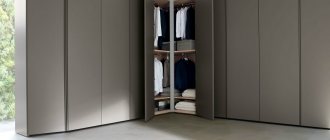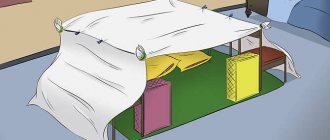Criteria for choosing a corner cabinet
Before purchasing furniture, you should decide on the following points:
- room measurements and space planning;
- stylistic design of the interior as a whole;
- what are the predominant color shades;
- the material from which all other furniture in the bedroom is made;
- organizing the interior space of the closet depending on the volume of the wardrobe;
Finishing
Finishing involves the following steps:
- all surfaces outside and inside are covered with a high-quality primer;
- joints are filled with gypsum plaster;
- then the serpyanka is glued;
- Painting corners are mounted at the corners;
- putty is applied, which is sanded after hardening;
- It is advisable to make two layers of putty;
- then the primer is applied again;
- then final finishing materials are applied, which can be represented by decorative panels, tiles or other materials.
It is advisable to use a mirror during finishing to increase the comfort of using the structure.
Perforated Angle Corner Finishing Cabinet
Store or online?
When choosing a cabinet, first of all, you should start from your own wishes and the size of the room. To make it easier to find the right model, you should look through the catalog of corner cabinets in the online store of a suitable company.
After looking at a large number of photos of corner cabinets, you can adjust your preferences and compare the available models with the size of the room.
After you make a choice, you should visit the store and examine the model in person. This will help you not to be disappointed in your find.
What materials are needed for manufacturing
First you need to decide on the material of manufacture. It could be as follows:
- Natural wood. It is rarely chosen for self-production, as it is highly expensive. In addition, even with some skills, working with it is very labor-intensive due to the capriciousness of the material, which will additionally have to be opened with special paints and varnishes.
- Chipboard. These are compressed slabs made from wood chips. They differ in the number of layers, thickness, formaldehyde content and type of cladding. Typically, slabs with a thickness of 16, 18 or 25 mm are used for the cabinet body. They have equal performance characteristics and differ only in their external effect: thicker slabs give the product a more solid appearance.
- MDF. These fibreboards are also made from sawdust, but are processed using dry rather than hot pressing. This processing method makes the material environmentally friendly, durable and aesthetic.
- Drywall. This material is low cost, easy to use, durable and environmentally friendly. Working with it does not require special skills.
In the interior of the rooms, all the details are thought through, from flooring, wall decoration and ending with furniture.
Note! Chipboard can be covered with a special interior film that imitates plastic or wood.
Required Tools
To work you will need the following tools:
- main material;
- pendants;
- profiles for forming a frame;
- glue;
- self-tapping screws;
- accessories;
- sheathing material;
- drill or hammer drill;
- Bulgarian;
- screwdriver;
- stationery knife;
- tape measure and level;
- jigsaw or hacksaw;
- hammer.
If you want to make sliding doors, you will also need guides and rollers. Optional use of mirrors.
Furniture should be multifunctional, ergonomic, reliable, durable and beautiful.
To ensure ease of use of the cabinet, various fittings are used. It is selected depending on the size of the structure, wall thickness and filling. For a standard cabinet you will need the following components:
- self-tapping screws;
- shelf holder;
- crossbar or pole;
- furniture hinges;
- adjustable support;
- screws;
- pens;
- nails;
- washers for screws;
- legs.
Use professional tools to create your cabinet.
Drawings and diagrams of a corner cabinet with dimensions
The following types of corner cabinet designs are distinguished:
- L-shaped;
- with five walls;
- triangular;
- in the shape of a trapezoid.
Cabinets can have perpendicular or diagonally located facades. There are also models:
- with and without mezzanines;
- asymmetrical and symmetrical;
- with external or internal drawers;
- combined or adapted only for shelves or hangers;
- designed for storing clothes or made in the form of open shelves and display cases;
- with a different number of facades (one-, two- and three-door).
Designs with perpendicular doors usually look like two ordinary cabinets with a slightly modified structure. Models are less often made cast, since this is not very convenient with sliding facades.
Everyone has their own preferences and tastes, but some generally accepted measures still exist.
Note! If there is a shortage of space, it is worth choosing a trapezoidal structure, since it is the most spacious even with minimal dimensions.
The dimensions of the cabinet are calculated based on the space available. A design occupying 600˟600 mm from the corner is considered to be the minimum possible. For a sufficient facade width (at least 400 mm), the depth of the sidewalls should not exceed 300 mm. Such a miniature cabinet is comparable in size to a wall-mounted kitchen module and can only be equipped with coat hooks and shelves. The barbell will no longer fit in it.
The size of the closet is determined by the size of the room.
For a cabinet with a compartment for hanging clothes, the distance from the corner must be at least 800 mm. In this case, the depth of the sides should be 450 mm if you plan to store light clothing, and at least 500 mm if you plan to store the top. If the cabinet is planned to be asymmetrical, then the dimensions from the corner can be 850˟650 mm, 800˟700 mm and so on. The main thing is to decide in advance on the desired dimensions in order to competently draw up a drawing.
The diagram is performed in two projections: front and side views. It indicates the external dimensions - height, width and dimensions of the box, as well as the thickness of the parts used. First, the structure box is depicted, then the internal filling.
Make sure to consider all the details when creating your cabinet.
The drawing must include an indication of the distances between the shelves, the width of the sections, the dimensions from the part to the mounting point and the height of the plinth.
Note! To open the facades freely, it is necessary to leave small gaps located on each side. This should also be reflected in the sketch.
The cabinet can be made of plasterboard and aluminum profiles.
Corner built-in wardrobe
Corner built-in wardrobe - as a rule, this type is made to order. Of the obvious advantages of this model, one can identify the implementation of the entire bedroom space, i.e. there is no extra space left, no empty “gaps” that disrupt the compositional structure of the furniture in the room.
A built-in wardrobe most effectively organizes and utilizes the bedroom space to suit the needs of the family. However, one of the disadvantages of this model is the higher price compared to a cabinet corner cabinet.
Also, it will be difficult to move a built-in wardrobe to a new location, since it was originally prepared for a specific space in the room.
This will require either abandoning the idea of moving, or additional expenses to change the shape and structure of this cabinet model.
Eurobook sofa - 130 photo recommendations on how to make and assemble a comfortable and compact sofaAssembling furniture with your own hands - 105 photos and a detailed video of how various furniture elements are assembled
Do-it-yourself bookshelves - ideas for building shelves and shelves quickly and easily from scrap materials (155 photos and videos)
Step-by-step instruction
Preparation
Shape and size
The shape of a corner wardrobe can be:
triangular _
This option is installed in a corner. This structure does not have side walls, and all the filling is attached to the walls. Such furniture looks harmonious in square rooms. It smoothes and hides corners to advantage;- trapezoidal .
This design has a small side wall on one side, which creates the shape of an irregular trapezoid. If you install additional structures, the internal space can be organized quite rationally; - L-shaped . The most common option. This universal shape is suitable for any room. An L-shaped cabinet is a combination of two straight pieces of furniture joined into one piece. This option allows you to make maximum use of the internal space, filling it with various components;
- five-walled . This form has small side walls that make the internal filling functional. Outside furniture can be supplemented with consoles and modules.
There are standard patterns and sizes for the manufacture of corner cabinets and non-standard ones. Standard patterns and sizes are:
if the room is large and of regular shape, a triangular model would be the ideal choice.
The length of the sides of such a product can reach 1.2 meters. If the length is about 1 meter, the furniture will turn out to be of little functionality and not roomy. And a length of about 1.5 m will make the piece of furniture too bulky. As for the minimum depth, it should be 40 cm, and the maximum - 60 cm.The internal space of the corner product can be anything. For small models it is worth choosing an L-shaped arrangement of shelves ;
- trapezoidal models fit perfectly into children's rooms, living rooms, and bedrooms. They are suitable even for small rooms where every free meter counts. The model has good capacity. The standard dimensions of a trapezoidal cabinet are: wall length - 1.2 and 0.8 m, depth 45 cm;
- five-wall products can have a height of 1.8 to 2.4 m, a width of 1.2-2.1 m, a depth of 85-100 cm. Such a piece of furniture is not suitable for cramped spaces . It is better to install it in a spacious living room or bedroom.
Advice. Experts recommend making a preliminary drawing of furniture on paper before manufacturing it. This will allow you to calculate the area of remaining free space.
As for non-standard products, it is advisable to install them in small, narrow and cramped spaces. When designing a drawing of a non-standard size corner wardrobe with your own hands, it is worth considering that:
- the minimum depth of the cabinet should be at least 35 cm. But the maximum permissible depth should not be more than 0.9 m;
- the minimum width of a non-standard piece of furniture must be at least 0.1 m. Then the doors will have a width of 45 cm. Narrower doors will be inconvenient to use and unstable;
- The height of non-standard products has no restrictions. Depending on the wishes and requirements of people, cabinets can be made as high as the ceiling. But the optimal comfortable height is 2.1 – 2.4 m.
Interior arrangement
When designing furniture, it is worth considering proper zoning of space. Namely, you will need:
- shelves for things . They are the main filling element. They can be made stationary or retractable, solid, ventilated, half or full depth;
- rods for shirts and other short items . Most often they are made of metal;
- hooks for bags and robes;
- shelves for shoes . In the upper part of the mezzanine it is convenient to store shoes in boxes;
- drawers for underwear and socks;
- trousers . Their trousers will always be ironed and ready to put on;
- tie bar . It will make it convenient for you to select products. They will not wrinkle or lose shape;
- belt hooks;
- pull-out baskets for small items. All things will be visible in them. It will be convenient to store bracelets, glasses, watches in them. The inside of the basket can be divided into separate cells.
Scheme and drawing
After you have decided on the size, shape, materials and design of the cabinet, you should draw a diagram indicating all the internal compartments, drawers, and shelves.
Advice.
If you own a PC, you can make a sketch using a special program. With its help, both simple furniture elements and quite complex ones are created.
When creating a project for future furniture, it is important to consider:
- product dimensions;
- dimensions of the door, base and cabinet lid;
- materials and dimensions of the rear part;
- internal space - vertical and horizontal sections, drawers, shelves;
- the presence of mezzanines;
- arrangement of accessories.
Materials and tools
An important criterion in the manufacture of furniture is the choice of consumables. For the manufacture of the frame the following is used:
- natural wood . Wooden products are the most durable and environmentally friendly. Such furniture will delight owners with its natural beauty, interesting texture and texture. But its cost will be quite high;
- MDF . This material has good performance characteristics, durability and affordable cost. Distinctive features of MDF are its ease of use, environmental friendliness and safety, excellent decorative qualities;
- Chipboard . It is distinguished by practicality, durability, reasonable cost, moisture resistance and aesthetics. Modern manufacturers provide a wide color palette of laminated chipboard. Thanks to this, stylish and original furniture pieces are obtained.
Doors can be made from:
- wood;
- plastic;
- MDF or chipboard;
- tempered glass.
Important . The durability of structures directly depends on the driving mechanisms. Therefore, special attention should be paid to the choice of fittings and guides. There is no need to skimp on these materials. It is recommended to purchase products only from well-established manufacturers.
To assemble a cabinet according to the finished project, you will need the following tools:
- hammer;
- screwdriver;
- drill;
- square;
- pencil.
Also, before installation, check the availability of:
- finished drawing;
- furniture board;
- guides and fittings;
- drawers, shelves, hangers, handles;
- dowels and screws;
- upper and lower false panels.
Manufacturing
How to make elements?
Having in hand a project for a corner cabinet with all the calculations, you can go to a company where they will cut out the materials for you.
If you decide to make all the details yourself, you need to:
- Cut out all the elements of the product from sheet material: walls, doors, shelves, drawer elements. You can make the parts using a circular saw. It is also possible to cut with a hacksaw, but in this case chips may appear on the parts.
- After this, we process the edges using PVC edge tape of a matching color. Trimming of cabinet elements can be done using an iron or a hair dryer.
- We apply the trim with the adhesive surface to the part and iron it with an iron or heat it with a hairdryer.
- We run a soft cloth along the edge, pressing it tightly against the product.
- We cut off the remaining tape with a knife.
Assembly of the structure
The corner cabinet can be built-in or cabinet. The assembly process for different structures is slightly different.
To assemble a built-in product, there is no need to install the back wall and corner ends . The product assembly process will consist of the following steps:
- If necessary, we process and level the walls in the room. We paint them or cover them with wallpaper.
- We drill holes in the places of future fastenings.
- We connect all the parts of the body.
- We check the work done using a level.
- Next we move on to the internal arrangement. We mark the location of the internal shelves of drawers and sectional partitions.
- We install doors.
The frame of the cabinet product is assembled according to the following principle:
- We make markings at the location where the piece of furniture will be installed.
- We assemble a special device from a metal strip and two pieces of board connected at an angle. You will also need 2 quick-release clamps. Using these tools, it is convenient to connect workpieces at right angles.
- We check the parts with a square and measure 7 cm from the top edge.
- We make marks for drilling on the upper and lower parts and drill the parts.
- Using a screwdriver, tighten the confirmat.
- After fixing the sidewalls, we place the location of the shelves and make holes for them. We install the crossbar and screw all the shelves.
- Next, we assemble the lower part of the furniture piece.
- After assembling the cabinet, a sheet of fiberboard is attached to the back of the cabinet using furniture nails.
- We install the door.
Door installation
The last step in assembling a corner cabinet with your own hands is installing the doors. They should be ordered separately from a company that deals with similar systems.
Sliding systems consist of the following elements:
- top guides;
- lower guides;
- the top of the door;
- bottom of the door;
- vertical stand for side parts;
- sealing rubber. It not only softens the opening and closing of the structure, but also prevents dust from entering;
- sets of upper and lower rollers;
- brackets for securing doors.
- vertical side profiles. They can be symmetrical or asymmetrical.
- door filler (mirror, wood, glass). Performs a purely decorative function, adding originality to the overall interior of the room.
Important . All door components must be covered with a protective film to prevent damage and scratches during delivery.
Instructions for assembling the doors are as follows:
- We place the door in a horizontal position so that it can be accessed from all sides.
- In the upper part of the vertical stand we make two holes for fastening - the bottom hole will have a diameter of 6.5 mm, and the top hole will have a diameter of 10 mm.
- At the bottom we attach a roller.
- We insert a rubber seal into the upper part of the mirror and fix it with a profile. We lay the seal around the entire perimeter.
- Next, install a vertical profile with a handle.
- We join the upper profile to the cross member and tighten the screw with a hex key. The screw is not screwed in completely, since the upper rollers will be installed into it later. Only after this is the screw tightened until it stops.
- Next, install the lower profile and tighten it with a hex wrench.
- We put on the final vertical profile and tighten the screw with the upper roller.
- We prepare everything for installing the lower roller, tighten the spring and carefully insert the roller into the drilled hole. We secure everything with a screw.
- Fix the top guide. We do not screw the bottom guide.
- We insert the lock for the door and set everything to the level. Only after checking that a gap of the same width is formed on the outside when the doors are closed, do we fix the lower guide with screws.
Advice. It is recommended to install clamps on sliding systems.
Cabinet/free-standing
Cabinet/free-standing – the model is easy to move, compact and versatile, a separate cabinet can be placed in any suitable place in the house.
This type is also affordable and allows you to create many options for interior planning. This model is suitable for people who do not require individual organization of space and complex compositional construction of furniture.
Stages of preparation for making a five-wall
When making a wardrobe with your own hands, do not try to saw the sheet material from which the side walls and doors will be made at home. It is almost impossible to manually achieve the required dimensional accuracy, especially for a corner wardrobe. Having decided on the dimensions of its sides and doors, it is advisable to use the services of a workshop where it is possible to ensure the required cutting accuracy. It is also advisable to process the ends that will be visible from the outside. The elements located inside the cabinet can be made independently.
Scheme for assembling a sliding door for a corner closet.
Before making a corner compartment with your own hands, check the installation location. This is especially important for the built-in option. Any unevenness in the floor or ceiling where the doors will move must be corrected. Otherwise, there will be problems with installing guides for moving doors.
Make sure that there are no electrical outlets or other elements that could affect the installation of the wardrobe yourself. Consider the size of the baseboards and, if any, moldings on the walls under the ceiling.
It is not advisable to save on a sliding door system. More expensive Italian or German designs will pay for themselves due to reliability and long-term operation.
There is no point in showing the specific design of the carriages. There are quite a lot of them, and each of them has its own installation characteristics. First you need to figure out how to install: the dimensions of the cabinet elements will depend on this. A more reliable option is a door with an upper running carriage. At the bottom of the door there will be a roller moving along a guide.
Before you start making a sliding wardrobe with your own hands, you should have the appropriate tool. When making a built-in version, a hammer drill is required. You will need a power tool to screw in the screws. It is advisable to have a hand-held circular saw with a guide fence. A hand saw will also work.
Related article: Characteristics of porcelain stoneware
You will need an angle clamp, a tape measure, a stapler, a soft and hard hammer, a drill with a set of drills, and a hex key for screwing in confirmations. To drill confirmation holes to a given depth, you will need confirmation drills. For simple drills, a stopper can be used.
It is necessary to purchase dowels, supports for shelves and screws.
Corner cabinet shapes
Triangular - simple to make, quite roomy, but in a small space it takes up a lot of space.
L-shaped - very effective in organizing corner space, especially if you need to take up space along a wall with a protruding corner.
Radial is an unusual shape that largely serves as decoration, but the model is quite expensive due to its original design.
- White table: 115 photos and videos describing the selection and construction of cool and easy-to-use tables
Do-it-yourself tabletop: video instructions for making a tabletop + 140 photos of the most modern ideas
Corner sofas - 130 photos and videos on how to choose and where to place modern original corner sofas
The pentagon is a very large storage space, and there are many variations of this shape that fit into rooms of different sizes.
Trapezoidal - good capacity, compact placement, suitable for almost any interior.
Design of the lower modules
- Kitchen floor cabinets are usually installed on adjustable legs, the height of which can vary from 10 to 15 centimeters. The legs can be made of either plastic or metal. The first ones, as a rule, are carefully covered with a kitchen plinth (for example, made of plastic) of the appropriate height.
Here the legs of the headset are hidden under the plinth
As for the metal legs, they are rarely covered with a base, since they themselves serve as a decorative element of the set. Also sometimes used is the technique of “recessing” the legs deep into floor-standing kitchen furniture modules - thus creating an interesting effect of the kitchen “hovering” in the air.
Decorative adjustable metal legs
- Modern trends in the design of kitchen sets suggest the use of drawers in simple lower modules, and swivel and rotating mechanisms in corner modules (as in the photo). Such internal equipment allows you to use the furniture as efficiently as possible and provides unhindered access to its contents.
Drawers
Unusual but very convenient corner mechanism
Design options
The design of a corner cabinet requires no less attention than other parameters, since it must be combined with the interior style of the room.
If the space is mainly decorated in light, pastel shades, then the cabinet should be chosen in the appropriate color scheme.
If the room is dominated by rich, deep colors, you can choose a palette of contrasts and give the room an eccentricity.
- Do-it-yourself computer desk: 150 photos of making corner tables and features of the choice of materials
DIY ottoman - step-by-step guide to the best homemade ottoman options (video + 125 photos)
Coffee table: simple and stylish design options and design ideas for coffee tables (115 photos)
Creating a Project
Before you start creating a drawing of the future structure, it is important to determine the place where it will be installed. At this stage, the following points should be taken into account: the number of shelves, drawers (if required). All this will allow us to develop the most detailed project.
It is important to observe the following nuances:
- Not all apartments have standard, smooth walls and ceilings. This is why measurements should be taken from all sides, especially when designing a built-in wardrobe.
- The depth of the finished cabinet should be at least 60 centimeters. Otherwise, such shelves will not be spacious.
- Measurements should be immediately transferred to the drawing in order to correctly calculate the amount of materials.
- If necessary, you should first level the floor in the place where you plan to install the cabinet.
- To apply markings, you must use a building level, a square and a tape measure.
Sample drawing with dimensions
The diagram of a corner cabinet is drawn starting from the sides, because they are load-bearing and represent the appearance of whole boards. Then you should determine the height of the structure (usually from 2.2 meters).
Only then do you need to calculate the dimensions of the horizontal parts and the rods (if it is a wardrobe). Most often, large shelves are installed at the top of the cabinet, and a bar directly in the corner. The last step is to add additional designations to the diagram where mirrors, lighting and other elements will be located.
Frame materials
Fiberboard coated with PVC, plastic or veneer
Mirrors – smooth, embossed, with or without engraving
Thick frosted or clear glass, can be decorated with engraving
Combined version of external design materials
Types of doors
Planning the location, type and functionality of corner wardrobe doors also requires attention and careful measurements.
Nothing should interfere with the opening of the doors; they should be comfortable and compactly fit into the space.
- swing - the most common option, familiar to use and simple. Requires additional room space, since the doors open outward from the cabinet;
- sliding – doors operate on the compartment principle, very convenient for limited space. A corner wardrobe can be placed in the bedroom provided that this model matches the style of the interior;
Preparing all the details
Most often, the closet has two compartments: a wide one with a hanger bar and a narrow one with shelves. An open pencil case can be located on one or both sides.
Open shelves are necessary for souvenirs and figurines.
The standard sizes of the basic elements are as follows:
- cabinet height – 180-220 cm;
- width of sections – 45-80 cm;
- distance between shelves – 30-35 cm;
- width of shelves and drawers – 40-45 cm;
- The depth of the drawers is 25-30 cm.
Note! For rational use of space, the upper part of the cabinet is equipped with mezzanines, and the lower part is equipped with a small compartment for shoes.
Don't forget to think about the interior of the cabinet.
When the drawing is ready, the parts are prepared. It consists of cutting materials into pieces of the required size and cleaning the cuts. If you have insufficient experience in such work or do not have suitable equipment, cutting can be done in a workshop.
Frame assembly
Before starting work, markings are carried out. Most often, built-in cabinets are made (especially from plasterboard), and therefore the designation of the position of parts and fasteners is applied directly to the wall.
Trust a professional to assemble your cabinet.
Installation of the frame is carried out as follows:
- Connecting electrical wiring to the place where the lamps are fixed. This is necessary if lighting is planned in the closet.
- Bonding rubber insulation to the guide profile. It should be located on the side that will be laid on the base of the furniture.
- Fixing the guides along the marking line. Dowels are used for secure fastening.
- Fixation of direct hangers.
- Installation of fasteners for hangers. Its choice depends on the base material. Dowels are suitable for concrete or brick, and screws or nails are suitable for wood, gas or expanded clay concrete.
- Inserting racks into vertical guides. They must be secured with hangers in the form of short self-tapping screws with a press washer.
- Installation of stiffeners between rack profiles. The stability and strength of the structure depends on their number. Most ribs should be installed in places where heavy items are stored.
When creating diagrams, first indicate the external dimensions of the product: the dimensions of the cabinet box, its height and width.
Note! To form the frame, it is worth using a metal profile, since wooden slats can dry out and absorb moisture, which will lead to changes in the size of the cabinet, distortions and increased fragility.
How to arrange the inside of a closet
For comfortable use, the closet must be properly zoned. This is especially true for a dressing room located in the hallway or bedroom.
Before making a cabinet, you need to take into account various nuances.
For this purpose, internal content may include:
- shelves that can be retractable or stationary, half or full depth, solid or ventilated;
- hanger rod;
- hooks;
- shoe shelves;
- drawers;
- belt hanger;
- trouser;
- tie bar;
- retractable baskets.
How to make a door
Most often, a corner closet is equipped with a swing door. For it, you need to install two fastenings - top and bottom. If the door is heavy, additional fasteners can be used, but no more than five in total.
Often the closet door is made of a mirror.
They should be located at least ten centimeters from the top and bottom corners to prevent the screws from coming out of the grooves. The step-by-step installation of fasteners is as follows:
- Make markings. To do this, the doors are fitted to the sidewalls. The length of the indentation from the edge of the sash to the center of the hinge should be about 2.2 cm.
- Drill the holes necessary for attaching the cups in the fixed sash. The recesses should not exceed 1.2 cm.
- Insert cups into holes. They should fit in without distortion. Screw the screws to the door part of the fastening.
- Install connecting parts. The drill must be held vertically.
- Connect the sash and side frame. At this stage you need to get help.
- Lubricate the mechanism with a small amount of oil. Wipe the surface with a cloth with good absorption.
Note! When using overhead parts, they must be made “blind” to avoid spreading during assembly.
Think carefully about your steps when creating a cabinet.
When planning how to make a corner cabinet with your own hands, you need to carefully calculate all the parameters so that the product looks organic. With careful, unhurried work, you can get an attractive, high-quality design.
Internal organization of a corner cabinet
Proper filling is the key to high-quality service of furniture. Even a small corner closet can accommodate the owner’s entire wardrobe if it is properly planned.
- Shelves are a standard way to store things;
- Drawers are very convenient for storing things, because... the space of the drawer is closed and limited, which prevents clothes from taking up a lot of space over time and falling out of the closet;
- Rails are an ideal solution for clothes that need to be hung and/or ironed, such as dresses, blouses, suits, jackets, etc.;
- Baskets – convenient for laundry and folding clothes;
Material selection
Table No. 3. The most common materials for making cabinets.
| View | Description |
| Natural wood | This is the most environmentally friendly and expensive option for making furniture. Cabinets of this type are distinguished by their strength, durability, and at the same time they have an impressive weight. In addition, wood products have an unusual decorative appearance, they have a unique texture. It is recommended to choose the most durable wood options - oak, pine. It should be taken into account that such material is deformed when exposed to high temperatures and humidity. In addition, it is exposed to pests. |
| MDF | This material is a mixture of wood chips, various fibers and resin. The main advantage of the material is its affordable cost. Thanks to proper processing, MDF boards are durable and quite easy to process. In addition, they do not deform over time and have a very fine texture that does not stand out. Another obvious advantage is the large size of the slabs. |
| Plywood | This is a fairly strong material that is suitable for creating a cabinet frame. It is recommended to use only multi-layer plywood for such purposes. Like natural wood, this material can become deformed as a result of exposure to moisture. |
| Drywall | This material is often used to cover the frame of corner cabinets. It is lightweight, so installation will not seem difficult even for a beginner. In addition, some types of drywall have good resistance to humidity and temperature changes. |
Corner wardrobes in a children's bedroom
Children's corner wardrobes are often planned with the expectation that they will accommodate not only clothes, but also books, school supplies, sports equipment and even the child's toys.
This design can be made to order or you can look for prefabricated models.
How to make a corner cabinet with your own hands using the example of a drawing
Let's consider a typical symmetrical model, with overall dimensions 2100x900x900mm. A do-it-yourself drawing of a corner cabinet will look like this. Along one of the sides, the width of the body allows for the placement of shelves; they must be made taking into account the required space for hanging the rod - from 500mm minimum. Drawers can be built into the section with shelves. The only nuance that should be taken into account in the future is the placement of hinges on the facade. The loop should not “get” into either the drawer or the shelf!
The height of the cabinet allows for the placement of two rods under clothes. A distance of 900-1100 mm is sufficient for short jackets and shirts, and the hem of long dresses can simply be “thrown” over the lower rod. Or you can make a shelf at the top or bottom, for hats or shoes.
Photos of corner cabinets
Tell your friends











